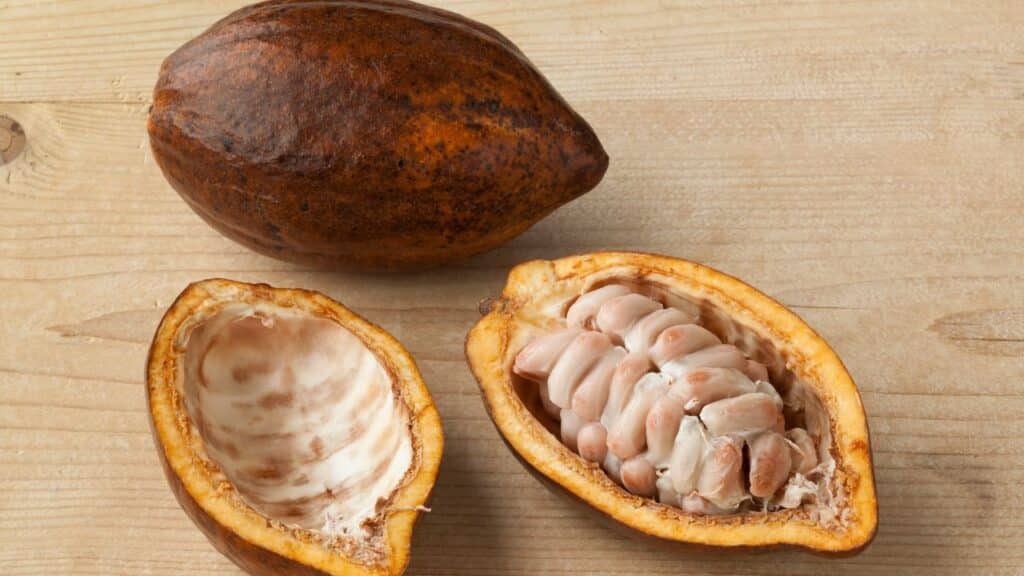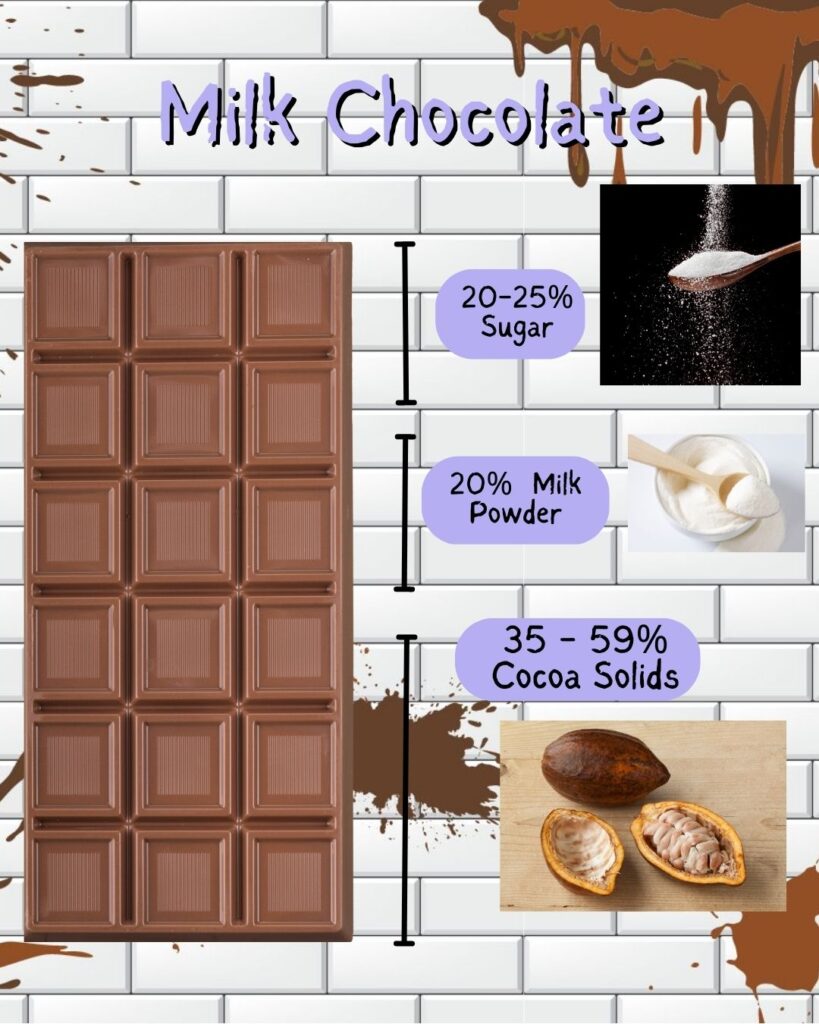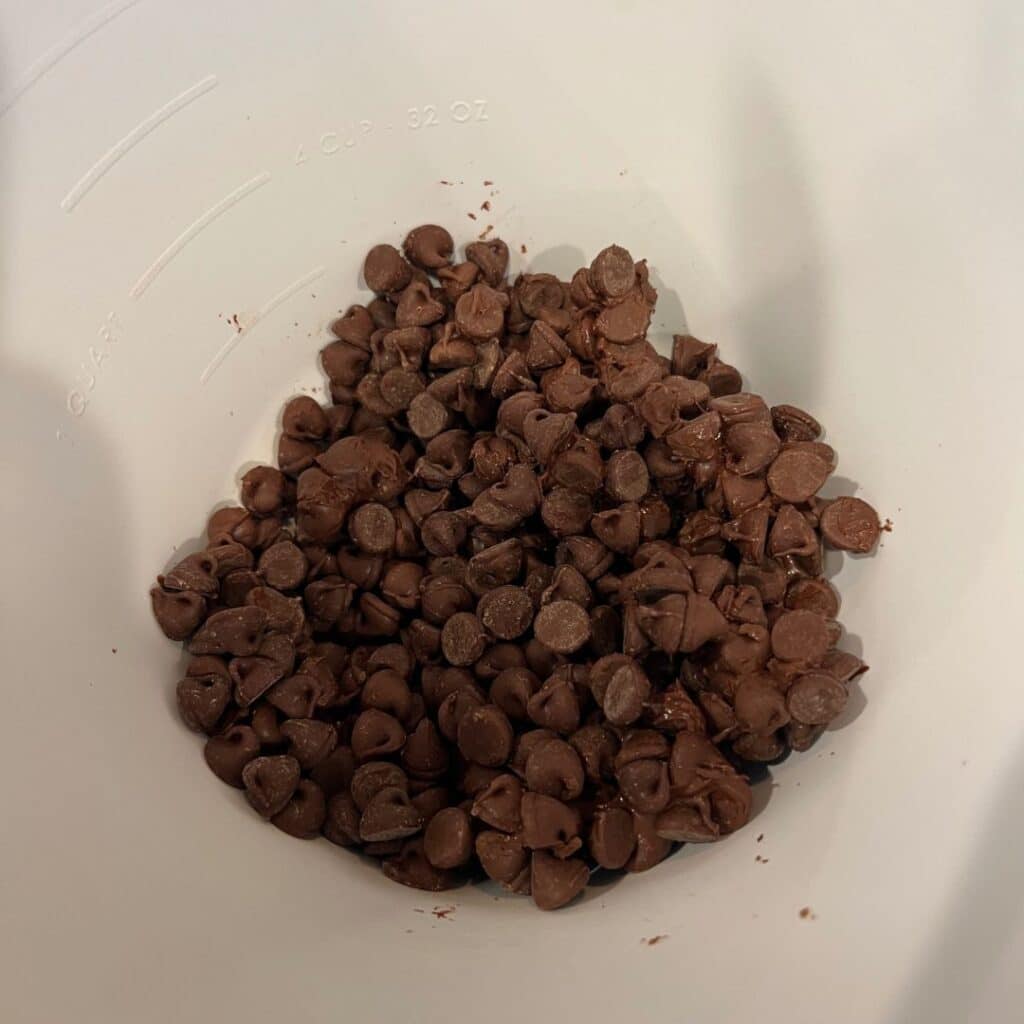Disclaimer: This post contains affiliate links. This means that I will receive a small commission from any purchase made from this post at no additional cost to you.
Chocolate is a bakers best friend. You can do so much with it. You can make truffles, You can use it as an ingredients in baked goods, you can temper it to make different candies ( like here), you can use it as a coating for all kinds of baking. So many things.
You just have to know a few basic things about how to work with chocolate that I am going to go over in this post. The first and most basic being “what is chocolate”?

Let’s Break It Down
- What is Chocolate? What is the Best Way to Describe It?
- Chocolate Composition, What Is Chocolate Made Of? What Is The Main Ingredient In Chocolate?
- What Does It Mean To Temper Chocolate?
- How Do I Know That My Chocolate Is In Temper?
- How To Store Chocolate
- How To Clean Up Chocolate
What is Chocolate? What is the Best Way to Describe It?
We all know what chocolate is but the technical definition is a food product that is made from the fruit of the cacao tree. That’s right guys, chocolate is a fruit.
And if you would like to learn more about that process of turning cacao beans instead to chocolate, you can click here.

Chocolate Composition, What Is Chocolate Made Of? What Is The Main Ingredient In Chocolate?
The exact composition of chocolate depends on the type of chocolate which we will discuss later but what it comes down to is that chocolate consists of 3 basic things. Chocolate consists of mostly cocoa solids, then cocoa butter and sugar.
Cocoa solids being the seed of the fruit called cocoa nibs or cocoa beans. When it comes to chocolates such as milk chocolate, there are more ingredients but in essence that’s all it is.



What Does The Percentage on a Package Of Chocolate Mean?
When you grab a package or bar of chocolate from the store, it has a percentage on it. Have you ever wondered what it meant? All that percentage is is the percentage of the bar the contains cocoa solids.
So if a bar is 65% cocoa, 65% of the bar is made of cocoa solids and the rest is sugar and cocoa butter. So as you can imagine, the lower the percentage the sweeter the bar, the higher the percentage the more bitter and stronger cocoa flavor is has.

Composition According To Each Chocolate
Dark Chocolate, Semi – Sweet Chocolate, and Bittersweet Chocolate
Dark chocolate has a cocoa percentage of 99 – 60%. So again, in my example where I personally made a 65% 100g dark chocolate bar 60% or 60g is cocoa solids or the cocoa beans, 5% or 5 grams was cocoa butter and the rest (35% or 35g) was sugar.
You can check out that whole process, here.
Bittersweet and semi-sweet chocolate also are technically dark chocolates.

Milk Chocolate
Then there is milk chocolate which has cocoa solids and sugar, as well as milk powder. This consists of 35-59 cocoa solids, 20% milk powder and 20- 25% sugar.

White Chocolate
White chocolate has no cocoa solids at all. Just 30-45% cocoa butter, 25- 40% milk powder and 25-55% sugar.

What Is The Difference Between Melting And Tempering Chocolate
Just simply melting chocolate will not ensure that your chocolate will come back together in a way that is shiny and shelf stable when it sets.
Now that is fine for so many things. If you don’t mind it not having those qualities than skip this step. It’s important to not that tempering or not tempering does absolutely nothing to the taste.
Tempering is a little more precise with certain temperature ranges to stay in and a very stringent process.
What Does It Mean To Temper Chocolate?
Tempering chocolate is the delicate process of heating and then cooling the chocolate in order to stabilize it. The trademarks of a good temper are that the chocolate cools back down to a very glossy shine, it’s stable at room temperature and it has a great snap when you break it apart.
Whichever method you use, it is much easier to use a thermometer. You can do without but it is much easier to check the temperatures as you go.
What Is The Science Behind Tempering Chocolate
So let’s talk science. If you are totally uninterested in the science of tempering chocolate or just in science in general, feel free to skip this whole section.
If you are a bit of a science nerd like myself and this stuff interests you, stick around.
Chocolate (like anything else) has a molecular crystalline structure. The molecules in cocoa butter break apart and come back together at different temperature, creating six different crystal forms.
The most common form being the fifth form that has a melting point of about 95• F. Meaning that it will stay solid at room temperature but will melt in your mouth.
So, to make sure that we only get form 5 beta crystals that form, we need to temper. Tempering is just melting the chocolate to higher than any of the melting points of all of the forms and then cooling it back down to below the melting point of the form that we want.
When you get the chocolate to a certain temperature, crystals start to form called seeding crystals. When seeding crystals are allowed to grow and get bigger by not heating the chocolate up too much, they then solidify, and your chocolate is stable at that crystal form.
But it’s not that simple. The temperatures that you temper chocolate at also depend on the type of chocolate.
Types of Chocolate Quality
There are a couple differant kinds of chocolate quality and that will determine whether you have to temper.
Compound Chocolate
The first is compound chocolate like candy melts. These are basically just oil and milk powder. This can just be melted and used to dip whatever you want.
Real Chocolate
This is the stuff that has to be tempered. If you look at the ingredients list and you see “chocolate” then it’s real. Now, just because a chocolate is “real chocolate” doesn’t mean all are same and one is just as good as another.
Chocolate Chips
Chocolate chips are perfectly fine to use but it is important to note that chocolate chips have stabilizers in them that make them more more difficult to melt. This makes the chocolate when melted a little thicker and not as fluid. This makes it a little more difficult to work with.
Couverture
Couverture is meant to be melted, tempered and poured into a mold, piped, used to dipping etc. So because of this, when melted the chocolate is more fluid and easier to work with
Which Temperatures To Use For Which Chocolate
Dark, Semi – Sweet, Bittersweet Chocolate
To temper, when originally melting the chocolate, do not let it go above 120•F. Then let this cool to 82•. Lastly, heat it again to between 88 – 91•F.

Milk Chocolate and White Chocolate
To temper milk and white chocolate, first melt the chocolate taking care to not let it exceed 105•F. Then let it cool to 82• F. Once there, heat it back up to 85•.

The Process of Tempering Chocolate And How To Work With Each Method
So, now we know the temperature that different types of chocolate temper at but what are the different ways that we can do that? I thought you’d never ask. Let’s talk about it.
How To Temper Chocolate With The Seeding Method
Seeding is the process of melting 75% of chocolate to the first temperture according to whichever kind of chocolate you are tempering in a double boiler.
A double boiler is just a bowl with whatever contents you want. In this case, chocolate. This bowl will sit inside a pot of shallow simmering water. It is so important that the bowl never touches the water. This could scorch the chocolate.
Then when all the chocolate is melted and you have brought the chocolate up to the first temperature, you will take the chocolate off the heat and add the remaining 25% of unmelted chocolate.
Vigorously stirring that in to melt it and in doing so that in will encourage the chocolate to cool faster to the second temperature.
When it’s all melted in it needs to be brought up to our third temperture. This is also known as the working temperature.

How To Temper Chocolate With The Tableing Method
With the tabling method, you will need a marble counter or marble slab, and 2 pallet knives. Start by melting your chocolate in a double boiler to the first temperture for your desired chocolate.
Then you will pour ⅔ of that chocolate on your marble slab. Use the 2 pallet knives to agitate the chocolate with the pallet knives and spread out thin. This constant motion and spreading out thin will help the chocolate cool faster.
Our goal here is to get the chocolate to cool to 82•F.
Then pour the chocolate back into the bowl with the remaining ⅓ of chocolate. Heat this chocolate to the third temperture according to your desired chocolate.

How To Temper Chocolate With The Microwave Method
The microwave method is by far the easiest in my opinion.
First, put 75% of the chocolate that you are melting in a microwave safe, plastic bowl and put it into the microwave for 30 second intervals high power, stirring in between until the chocolate is half melted and then do 15 seconds until the chocolate is completely melted.
It is important to use plastic because glass or ceramic bowls hold onto heat, making it easier for your chocolate to overheat.
Then with the other 25% of unmelted chocolate, you are going to add that in in small handful stirring in between until completely melted. This all just by stirring. Not heating it anymore.
If the chocolate doesn’t fully melt you can pop it into the microwave for 10 seconds to warm it slightly. We just don’t want it over 84•F if it’s dark or semisweet chocolate and 85•F if it’s milk or white chocolate.







How To Temper Chocolate With Cocoa Butter Crystals(Beta Crystals)
Beta Crystals are freeze dried cocoa butter powder. All you have to do with this is melt your chocolate, cool it to between 88 and 91•F• if you are working with dark or semi sweet chocolate and 85• and 87• if you are working with milk or white chocolate.
Then just simply add in a couple scoops of this powder. Mix it in and that’s it. It’s ready to use. This can be found on amazon and I will link it below.
How To Temper Chocolate With The Sou Vide Method
A Sous Vide is a cooking device that is used to heat a tub of water to a certain temperature (in this case to the first temperture according to your desired chocolate) Then, cooled to 82• F. Then back up to whatever the third temperature according to your desired chocolate is.
This method is great because it ensures that the temperature never goes over the temperature that you set it at. It doesn’t matter how long you leave it. It will stay precisely at that temperature.
To do this though, you have to make sure that absolutely no water gets into your chocolate because as you may know, water and chocolate are not friends. Just a drop of water will cause chocolate to seize and be ruined.
So you can do a few things. You can put the chocolate in a vacuum sealed bag or you can put it in a double bagged zip locked bag that is clipped to the side of the tub of water.


How To Temper Chocolate With a Machine
Tempering chocolate in a chocolate melting machine is pretty much exactly the same process as the seeding method. Just melt 75% of the chocolate in the tempering machine by setting it to the desired temperature ( 120• for dark, semi-sweet, and bittersweet chocolate and 105• for milk and white chocolate).
Once your chocolate is melted, take the chocolate off the heat and just add in your seed chocolate and stir that in. Once melted and at 82• you can add it back to the machine and set the machine to working temp.
How Do I Know That My Chocolate Is In Temper?
To test if your chocolate is in temper, just dip the back of a spoon or a piece of parchment paper into the chocolate and it should set in 3-5 minutes. It should look shiny, leave no residue on your fingers and have a clean and crisp snap.
What If My Chocolate Isn’t In Temper?
If your chocolate isn’t in temper there are a couple things that you can do. The first thing is to make sure that your chocolate isn’t too hot or too cold. Are you in working temperature (third temperature)?
If that still doesn’t work, you can reuse the same chocolate to redue the whole process.

How To Store Chocolate
For the easiest clean up, pour any excess chocolate that you have melted into the container that you would like to store it in. That will keep for months at room temperature.
What If My Chocolate Is In A Squeeze Bottle?
If your chocolate is in a squeeze bottle and you want to save the extra, just simply put that bottle into the freezer for a few minutes.
When the chocolate is set and hardened, just simply take the top off and squeeze the sides of the bottle so that the hardened chocolate crack off. Once all the chocolate is off the sides just shake all the chocolate out into whatever container we want. Leave at room temperature.
How To Clean Up Chocolate
The best tip to clean up chocolate is time. Do not give the chocolate time to set. It is a huge pain in the neck to clean it up when the chocolate is so stuck on. Get it right in the sink and run hot water and soap into it.

Phew…. that was a lot. If you have made it this far, thanks you so much for reading and I hope this answers all of your questions about how to work with chocolate.
Chocolate really is quite simple to work with, you just need these few guidelines and some practice.
If you have any additional questions, please don’t hesitate to ask. And if you have any techniques or tips that I didn’t share. I would love to hear them in the comments below.
If you liked this post and you want to learn how to tackle cheesecake next, click here. How about cake? Bread?
Follow me on Facebook, Instagram, pinterest , twitter and snapchat to see what I’m up to next. Remember, don’t be afraid to bake a mess. And I’ll see you all next time. Happy Baking!